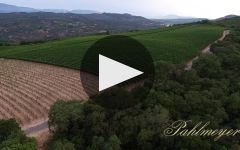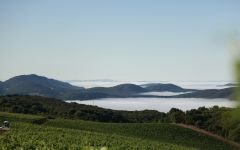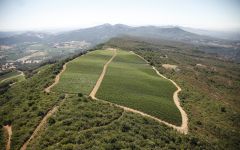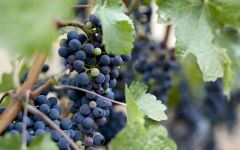Pahlmeyer Napa Valley Proprietary Red 2019
-
James
Suckling -
Wine
Enthusiast -
Robert
Parker -
Wine
Spectator



Product Details
Your Rating
Somm Note
Winemaker Notes
The 2019 Pahlmeyer Proprietary Red is a rich and finely detailed tapestry of the finest lots across their four mountain vineyards. The bounding aromas flicker between fruity and earthy with an interweaving of wild blueberry, black plum, cassis, saddle leather, and cedar. The opulent palate is layered and expansive with captivating flavors of crushed ripe blackberry and castelvetrano olive. The focused fruit core is framed by generous fine-grained tannins, surging long with an echo of earth and spice.
Blend: 78% Cabernet Sauvignon, 15% Merlot, 4% Petit Verdot, 3% Cabernet Franc
Professional Ratings
-
James Suckling
Blackberries, blackcurrants and hints of mint. Full-bodied with very fine, velvety tannins. Turns firm and structured with a fine chewiness and a caressing mouth-feel. Lively, too...Very attractive now, but will be better in four to five years. Try after 2026.
-
Wine Enthusiast
Serious and sophisticated, this opulent wine drips with concentrated blueberries, black cherries and dark chocolate on a massive frame of tannins that is surprisingly velvety and enticing. Subtle oak spices like graphite, espresso and crema add tasty nuances. Katie Vogt blended this beauty from 77% Cabernet Sauvignon, plus Merlot, Petit Verdot and Cabernet Franc.
-
Robert Parker's Wine Advocate
Mainly off the estate vineyard and mainly Cabernet Sauvignon (77%), Pahlmeyer's 2019 Proprietary Red spent 18 months in almost all new French oak. Gentle herbal notes accent cherry and cassis on the nose of this full-bodied wine, which manages to be rich and velvety without ever being heavy. Waves of ripe fruit, cedary oak and savory loam linger on the long, elegant finish. This should drink well for up to two decades.
-
Wine Spectator
Offers lots of fun, juicy blackberry and dark plum compote flavors tossed with cocoa, licorice root and Black Forest cake. Fruit-driven and frankly toasted on the finish, but has the energy for balance. Cabernet Sauvignon, Merlot, Petit Verdot and Cabernet Franc.
Other Vintages
2018-
Jeb
Dunnuck -
Robert
Parker -
Wine
Enthusiast -
Wine
Spectator -
Wine &
Spirits
-
Jeb
Dunnuck -
Robert
Parker
-
Robert
Parker -
James
Suckling -
Tasting
Panel -
Jeb
Dunnuck -
Wine
Spectator
-
James
Suckling -
Robert
Parker -
Wine
Enthusiast -
Wine
Spectator - Decanter
-
James
Suckling -
Wine
Spectator - Decanter
-
Robert
Parker -
Wilfred
Wong
-
James
Suckling -
Robert
Parker -
Wilfred
Wong -
Wine
Spectator
-
James
Suckling -
Robert
Parker -
Wine
Spectator
-
Wine
Spectator -
Wine
Enthusiast
-
Robert
Parker -
Wine
Spectator -
Connoisseurs'
Guide
-
Robert
Parker
-
Robert
Parker -
Wine
Spectator
-
Robert
Parker -
Connoisseurs'
Guide -
Wine
Spectator
-
Robert
Parker -
Connoisseurs'
Guide -
Wine
Spectator
-
Wine
Spectator -
Robert
Parker
-
Robert
Parker
-
Wine
Spectator -
Robert
Parker
-
Wine
Spectator -
Robert
Parker
-
Robert
Parker -
Wine
Spectator
-
Robert
Parker -
Wine
Spectator
-
Robert
Parker
-
Robert
Parker -
Wine
Spectator







Pahlmeyer was founded in 1986, by a desire to be great by its eponymous creator Jayson Pahlmeyer. With a dream to create a California Mouton, Jayson and his partners spared no resource to make this dream a reality. Whether it was finding the perfect piece of land high atop Napa Valley’s Atlas Peak or covertly smuggling in Bordeaux cuttings, all pieces of Pahlmeyer’s history have led to its place as one of the top brand names from Napa Valley. From the very beginning, Pahlmeyer has been dedicated to crafting fine wines from the best fruit sources possible. In California, this means high elevation mountain sites, where the grapes are afforded more sunlight, cooler temperatures, and less fertile soils, which together create ideal conditions. Pahlmeyer sources the majority of their fruit from four key locations: Pahlmeyer Estate (Atlas Peak), Stagecoach (Atlas Peak / Pritchard Hill), Rancho Chimiles, and Antica.

Undoubtedly proving its merit over and over, Napa Valley is a now a leading force in the world of prestigious red wine regions. Though Cabernet Sauvignon dominates Napa Valley, other red varieties certainly thrive here. Important but often overlooked include Merlot and other Bordeaux varieties well-regarded on their own as well as for their blending capacities. Very old vine Zinfandel represents an important historical stronghold for the region and Pinot noir is produced in the cooler southern parts, close to the San Pablo Bay.
Perfectly situated running north to south, the valley acts as a corridor, pulling cool, moist air up from the San Pablo Bay in the evenings during the hot days of the growing season, which leads to even and slow grape ripening. Furthermore the valley claims over 100 soil variations including layers of volcanic, gravel, sand and silt—a combination excellent for world-class red wine production.
